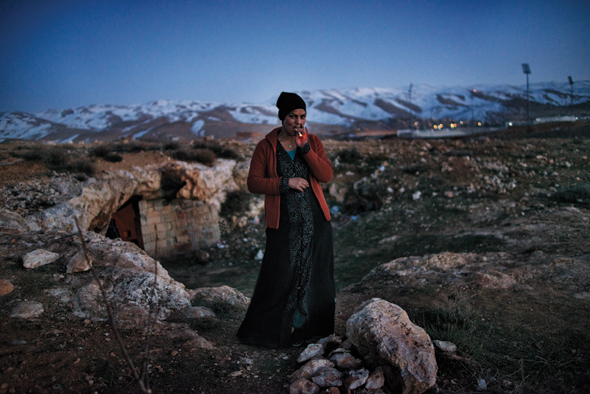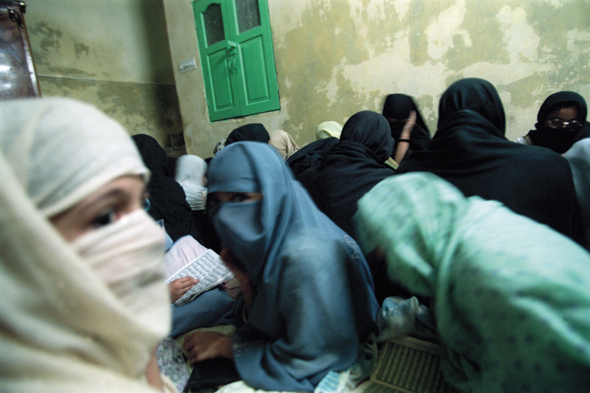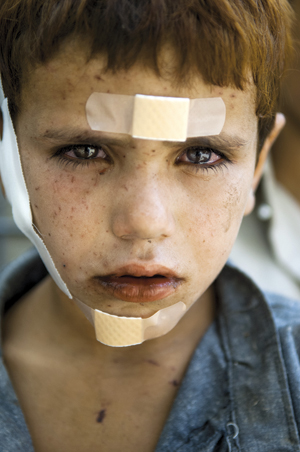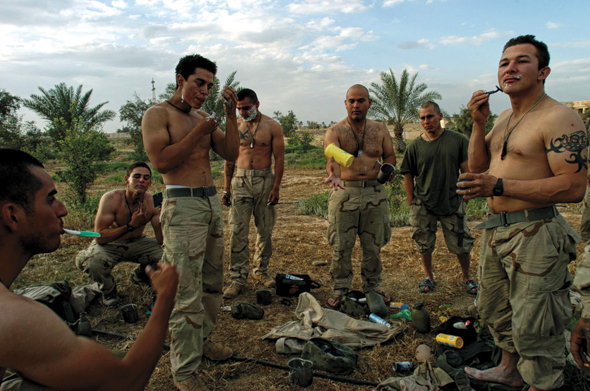
Uprooted A 21-year-old refugee from the Syrian civil war outside the cave she and her family were living in after fleeing to Lebanon in January 2013. (Lynsey Addario)
A few months ago, trolling through The New York Times website, I came across a slideshow on Syrian child brides in Jordan by the gifted photographer Lynsey Addario. I watched the images unfurl: a striking silhouette of a pregnant 17-year-old refugee standing next to an unmade bed in a darkened room; a group of mostly married girls in head-scarves, looking like giggling teenagers at the mall; a sly and intriguing photo of pregnant and lactating women at a refugee camp, shot through a screen.
Then came an image that stopped me. It depicted a girl in an emerald headscarf sitting in a dim room with a baby on her lap. The caption said she was a 16-year-old who had left an abusive marriage to return to her family, but it wasn’t her dramatic story that caught my attention. It was the light. The baby is little more than a suggestion in the dusky room, but from somewhere outside the frame a ray of white sunlight falls directly on the girl’s face, brightening her exposed forehead and the green headscarf covering her nose and mouth and giving the image the chiaroscuro quality of a Caravaggio. As I stared at it, I felt some of the excitement I imagined Addario might have felt at capturing that moment, that light, in just the right place, with the right girl in the right-colored headscarf.
“A perfect photograph is almost impossible; a good one is hard enough,” Addario writes trenchantly in her engaging memoir, It’s What I Do. “Sometimes the light is there, but the subject is in the wrong place, and the composition doesn’t work. Sometimes the light is perfect, but the subject is uncomfortable, and his awkwardness shows. I learned how difficult it is to put all the elements in place.”
While in captivity, a Libyan soldier held a cellphone to Addario’s ear so his wife could insult her: ‘You are a dog. You are a donkey. Long live Muammar.’
Addario makes good pictures most of the time; occasionally, she pulls off a perfect one. Some of both are included in her memoir, hidden like buried jewels between long stretches of prose that recount a thrilling and lucky life. The photo of the Syrian teenager with the baby captures exactly the kind of moment that Addario claims to grasp more fully now that she is a mother herself. “My experience as a parent has taught me a new understanding of the subjects I photograph,” she writes.
Addario didn’t always think that motherhood would benefit her work–quite the opposite. In 2009, after she was injured in a car accident while on assignment in Pakistan, friends suggested that she take a break from work and get pregnant, as her fiancé had been urging her to do. Addario was infuriated. “If I took six months off to have a baby, I believed I would be written off by my editors,” she writes. “I was in a man’s profession. I couldn’t think of a single female photojournalist who was married or had a child.”

Access Women studying the Koran in Peshawar, Pakistan, 2001. Addario realized she could go places and get photographs her male colleagues could not. (Lynsey Addario)
It’s What I Do is a story of guts, professional ambition, and personal growth that will be familiar to a generation of journalists who came of age on the battlefields of America’s war on terror after the attacks of September 11, 2001. It is also the story of a woman making her way in a man’s world, whether she’s fending off men grabbing her ass while shooting on the streets of Pakistan, or being told by a male correspondent that her being a woman will interfere with their access to a prominent Afghan leader they’ve been assigned to profile. (Addario quickly finds her way to the warlord’s mansion, and is busy shooting when her colleague shows up.)
Addario has spent much of her career photographing war. She has done difficult, dangerous duty in Afghanistan and Iraq, with side trips to such garden spots as Somalia and Libya, where she was famously kidnapped with three other New York Times journalists in 2011. Her memoir recounts these adventures, along with scenes from a disappointing love life: a cheating boyfriend, an ill-fated war-zone affair, and a string of other passionate disasters that make her doubt her long-term romantic prospects. “I worried sometimes whether I was condemning myself to a spinster’s future: forever single, having affairs with random men, my cameras dangling all over me,” she writes. “It could have been worse.”
While Addario’s photos of battle are effective as journalism, her images of ordinary people, especially women and children, at the edges of conflict transcend news. Her book includes a striking picture of a Cuban couple watching Fidel Castro on TV that Addario took when she traveled to Havana on her own dime during a break from covering press conferences, accidents, and the Yankees’ ticker-tape parades as a young AP stringer in New York.
In 2000, having moved to India to freelance, she traveled to Taliban-ruled Afghanistan, borrowing money from her sister to pay for the trip. Once there, she was at first “too nervous” even to shoot the landscape from the window of a moving car, but she finally worked up the courage to ask her translator if she could photograph him after prayers. The result is a gorgeous image of a vanishing human figure against a monumental landscape of mountains and sky. “From then on, I knew to search for moments like that–more intimate, more private,” she writes. This insight serves her well in Kabul, where she shoots covered women in a hospital, and later in Chad, Sudan, and Congo, where her photographs evoke, stun, and flirt with abstraction. It is worth asking what Addario’s being female has to do with her preference for capturing the “private” and “intimate,” and what her story can tell us about the special barriers and opportunities for women working internationally, particularly in war zones.

Collateral damage A 7-year-old boy who village elders say was wounded by shrapnel from a US bomb during fighting in the Korengal Valley, Afghanistan, in October 2007. (Lynsey Addario)
Addario grew up in westport, ct, the youngest of four daughters born to hairdressers who threw lavish pool parties and opened their homes to drag queens and other figures of the suburban counterculture. When Addario was eight, her father left her mother for a man who was a close family friend. Addario and her sisters lived with their mother, whose income plummeted after the split. They moved to a smaller house without a pool, and their mother gave up her two-seater Mercedes.
When Addario was 13, her father gave her her first camera, a Nikon FG. She went off to Madison, WI, for college, where she studied international relations and took lots of pictures, but didn’t plan to become a photographer. “I thought photographers were flaky, trust-fund kids without ambition,” she writes.
After graduation, she waited tables, saved money, and then moved to Buenos Aires to learn Spanish and make pictures. “My quest was simple: to travel and photograph everything I could with what little I had.” Eventually, at the suggestion of a boyfriend, she approached the editors at an English-language daily and offered to be a freelance shooter. Her big break came when Madonna was filming Evita in Buenos Aires. “I will be famous someday . . . if you just let me in,” she told the security guards stationed around the set. They obliged, and her picture made the front page of the Buenos Aires Herald.
This is the first time we glimpse the scope of Addario’s ambition, but not the last. A visit to a Sebastiao Salgado exhibit in Buenos Aires erased her youthful sense that photography was a job for trust-fund kids. “I was so overcome by his images–the passion, the details, the texture–that I decided to devote myself to photojournalism and documentary photography,” she writes. She worked hard, and she had big dreams. “I wanted people to recognize my photographs, to be affected by my work,” she writes. “The more I worked, the more I achieved, the more I wanted.” After moving to New Delhi to freelance, she emailed The New York Times photodesk over and over, but received no answer. “I felt that if I could only shoot for The New York Times–to me, the newspaper that most influenced American foreign policy and that employed the world’s best journalists–I would reach the pinnacle of my career.”
She got her chance in Pakistan after the 9/11 attacks. Addario knew that she would have access to areas off limits to men, so she began visiting women’s madrassas. “I was getting photographic material and access I wasn’t seeing in other publications,” she writes. Her “Women of Jihad” series appeared in The New York Times Magazine in the fall of 2001, a giant coup for a young freelancer.
Addario’s career took off after that. From Pakistan and Afghanistan, she headed to Iraq, where she photographed her first bombing and experienced the death of a colleague for the first time. Covering war became a way of life: From the roof of the Times house in Baghdad, she could see plumes of smoke from explosions, and knew which way to drive for the story. Back home in Istanbul, she reunited with her feckless boyfriend but felt like “a caged animal.” When she found photographs of a woman in a drawer, she barely had the energy to confront him. “I accepted his philandering as one of the compromises of the work and lifestyle I had chosen,” she writes. Soon, she returned Iraq, “happy to be back to the world I understood. In Iraq I didn’t have to worry about finding pictures of strange women in my drawers, or wonder why no one cared that a war was going on.”
She sought solace in an affair with a fellow Times correspondent, and sent her cheating boyfriend packing. But in 2004, she and her lover, whom she identifies only as Matthew, were kidnapped outside Baghdad and held for several hours by Iraqi insurgents. Addario thought she was going to die. When she made it back to Baghdad and called her father, he begged her to come home. But Addario didn’t want to leave. She “accepted fear as a byproduct of the path I had chosen,” much like her boyfriend’s infidelity. She tried to pull herself away from deadline work in violent places, but only half succeeded. After Iraq, she headed to Darfur, and developed an interest in Sudan that would keep her returning for years. Soon, though, she was back in Afghanistan, where she undertook one of the most difficult and dangerous assignments of her life, spending weeks embedded with US troops in the Korengal Valley, where constant gunfights killed dozens of soldiers.
Addario made that trip with New York Times Magazine correspondent Elizabeth Rubin, who was pregnant at the time. When she and Addario opted to stay back with the command element during a battle, two male photographers beat Addario to the action. “I felt like a failure and sensed the limitations of my gender,” Addario writes.
Later, Addario climbed a hill to pee during a night patrol and got caught in the middle of a gunfight. Spooked, she asked to leave the embed early, noting that “the only thing that had kept me alive during Iraq, Afghanistan, Lebanon, Congo, and Darfur was my inner voice that told me when I had reached my personal limit of fear.”

Beyond the front US Marines freshen up outside one of Saddam Hussein’s palaces after driving the Republican Guard out of Tikrit. (Lynsey Addario)
Addario trusts her instincts–most of the time. She has years of experience, and her work has been honored with a MacArthur genius grant and a Pulitzer Prize, yet she continues to be plagued by self-doubt. When she left the Korengal embed early, she was overcome with regret at abandoning Rubin. Back in Istanbul, she cried in the bathroom, reproaching herself for “being an inadequate journalist.” In Libya, she was terrified almost from the start, but didn’t leave soon enough. Minutes before she and her male colleagues were detained in Ajdabiya, Addario recalls watching a group of French journalists, known for their machismo, speed out of town. “I said nothing,” she writes. “I didn’t want to be the cowardly photographer or the terrified girl who prevented the men from doing their work . . . . My colleagues would never have accused me of being wimpy or unprofessional; I was the one who was all too aware of being the only woman in the car.”
At least three of the four Times journalists seized that day–Addario, fellow photographer Tyler Hicks, and reporter Steve Farrell–had been detained before; the fourth, Anthony Shadid, had been shot while reporting in the West Bank. At a time when conflict journalists are increasingly becoming targets of violence, Addario writes, such dangers “had become the job.” As they awaited their fate, Farrell vowed to stop going to war. The others stayed silent, knowing they would keep taking dangerous assignments. “Journalism is a selfish profession,” Addario writes. “But I still believed in the power of its purpose, and hoped my family did too.”
Addario and her Times colleagues have written already about their kidnapping, but Addario adds details that highlight the bizarre and creepy mindset of their Libyan captors and the Libyan officials who managed their transfer out of the country. A Libyan soldier held a cellphone to Addario’s ear so his wife could insult her: “You are a dog. You are a donkey. Long live Muammar.” Addario was not raped in captivity, but she was repeatedly groped. When they were delivered to Libyan government custody, an interpreter asked if she needed any “feminine things.” “I found it odd that the Libyans would tie us up, beat us up, psychologically torture us for three days, and then offer to buy me tampons,” Addario writes. Later, the same interpreter brought her a bag of clothes that included underwear with the words “shake it up!” on the front.
It was in Libya, in captivity, that she pledged to get pregnant if she made it out alive. But when she was reunited with her husband and, shortly thereafter, learned she would soon have a child, she prayed that the pregnancy tests were wrong. “I was not at all ready to give up my life, my body, my travels,” she writes. She flew off to Senegal, Saudi Arabia, Afghanistan, and Mogadishu. “I was holding on to my identity, my freedom, what I had been working toward my entire adult life–as well as panic that it was all about to disappear with the birth of my child.”
When she was six months pregnant, Addario traveled to Gaza on assignment for the Times to photograph a prisoner exchange. On her return to Israel, she arranged to avoid the full-body scanner at the Erez checkpoint, fearing the radiation could harm her unborn child. But when she got to the checkpoint, a rude Israeli soldier gave her a choice: the scanner or a strip search. She was made to pass through the scanner three times, then asked to take off her clothes. Furious, Addario realized that if she was being subjected to such treatment as an American from The New York Times, a poor, pregnant Palestinian woman must have it even worse. “I could suddenly understand, in a new, profound, and enraging way, the way most people in the world lived,” she writes. “I had been seeing that reality for years. But somehow, I had to admit, my pregnancy and the vulnerabilities of motherhood had offered me yet another window on humanity, yet another chance at understanding.”
Addario’s pregnancy didn’t set her career back as she’d feared. Her Times editor promised to give her work, even after she had her baby. “I was shocked by his reaction,” Addario writes. She wondered whether “the industry was changing a little. Was it possible that I had finally proven myself enough?” Her question conveys the insecurity that some female war correspondents feel, even after they have become more macho than the men. Since September 11, a growing number of women have gained prominent positions covering conflict for major news organizations. But the path to those jobs–which are exhausting, dangerous, and often make a stable and nurturing personal life impossible–is paved with stories that male editors find interesting and important. Female journalists sometimes put themselves in more difficult and dangerous situations than might be strictly necessary to show they are tough enough to hack it.
But why is the best story necessarily in the midst of combat? And who decides that is the best story, or the only story worth telling? On her first trip to Iraq in 2003, Addario decided to go north to Kurdistan, to “work around the edges,” because she suspected she lacked the physical stamina to embed with the military invading Baghdad. But working at the edges should not be seen as a handicap. The best stories and the best pictures are arguably always around the edges, in the private and intimate spaces where people live and adapt, suffering or thriving in war’s lurid half-light. These are stories that Addario and other female journalists are uniquely equipped to tell.
Vanessa M. Gezari is the managing editor of CJR and author of The Tender Soldier, which came out in paperback in August 2014.
